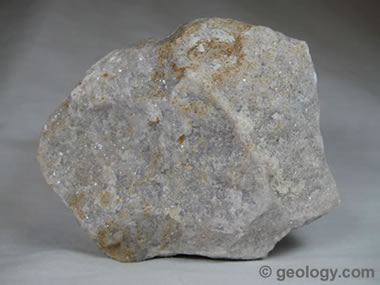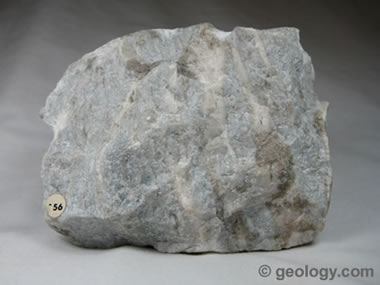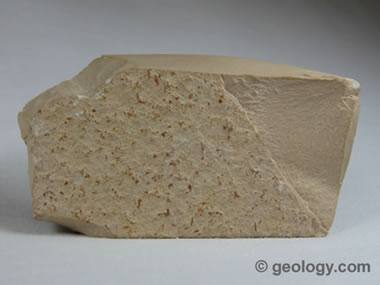Anhydrite
An evaporite mineral used as a soil treatment and to produce construction materials
Article by: Hobart M. King, PhD, RPG

Anhydrite: Anhydrite from Balmat, New York. This specimen of massive anhydrite has a typical gray color and a sugary appearance on broken surfaces caused by exposure of cleavage faces. Specimen is approximately 4 inches (10 centimeters) across.
What is Anhydrite?
Anhydrite is an evaporite mineral that occurs in extensive layered deposits in sedimentary basins where large volumes of sea water have been evaporated. It is typically interbedded with rocks that include halite, gypsum, and limestone. These accumulations can be hundreds of feet thick. On a smaller scale, anhydrite can form in shoreline or tidal flat sediments from the evaporation of sea water.
Anhydrite also occurs as a vein-filling mineral in hydrothermal deposits. It is deposited from solution, often along with calcite and halite, as gangue in sulfide mineral deposits. Anhydrite is also found in the cap rock of salt domes.
Anhydrite is an anhydrous calcium sulfate with a composition of CaSO4. It is closely related to gypsum, which has a chemical composition of CaSO4.2H2O. The worldwide abundance of gypsum greatly exceeds the abundance of anhydrite.
Anhydrite Etymology
Anhydrite receives its name from the Greek "anhydrous" which means "without water." It readily converts to gypsum under humid conditions or in contact with groundwater. This transition involves the absorption of water and a significant change in volume. That expansion can cause deformation in the rock units. If gypsum is heated to about 200 degrees Celsius, it will yield water and be converted to anhydrite. This reaction occurs much less often.
Physical Properties of Anhydrite |
|
| Chemical Classification | Sulfate |
| Color | Colorless, white, and light shades of brown, red, gray, pink, blue, violet |
| Streak | White |
| Luster | Vitreous to pearly |
| Diaphaneity | Transparent to translucent |
| Cleavage | Perfect cleavage in three directions to form cubic-shaped cleavage fragments |
| Mohs Hardness | 3 to 3.5 |
| Specific Gravity | 2.9 to 3 |
| Diagnostic Properties | Cubic cleavage, harder than gypsum, higher specific gravity than calcite, no acid reaction. |
| Chemical Composition | CaSO4 |
| Crystal System | Orthorhombic |
| Uses | Soil treatment. Ingredient in plaster and other construction materials. |

Anhydrite: Massive anhydrite from Balmat, New York showing sedimentary layering and sugary appearance on broken surfaces. Specimen is approximately 4 inches (10 centimeters) across.
Physical Properties and Identification
One of the most distinctive properties of anhydrite is its cubic cleavage. It cleaves in three directions at right angles. This can easily be seen in coarsely crystalline specimens or with a hand lens in fine-grained specimens. This distinctive cleavage has earned anhydrite the nickname of "cube spar."
Anhydrite can be a small challenge to identify when it occurs in massive form. It can be confused with gypsum, calcite, or halite - which it is almost always associated with. Compared to gypsum, anhydrite exhibits cleavage in three directions at right angles and has a greater hardness. Its right angle cleavage and lack of acid reaction allows it to be distinguished from calcite. Compared to halite, anhydrite is insoluble and slightly harder.

Anhydrite: Anhydrite from Mound House, Nevada with a very fine texture that could be confused with lithographic limestone. Specimen is approximately 4 inches (10 centimeters) across.
Uses of Anhydrite
Anhydrite can be substituted for gypsum in some of its uses. Both minerals are crushed for use as a soil treatment, and in this purpose anhydrite is superior. One ton of anhydrite has more calcium than one ton of gypsum - because gypsum is about 21% water by weight. This yields more calcium per ton in a soil application. Anhydrite also has a higher solubility, which helps it benefit the soil quickly.
Small amounts of anhydrite are used as drying agents in plaster, paint, and varnish. It is also used along with gypsum to produce plaster, joint compound, wallboard, and other products for the construction industry. Anhydrite has also been used as a source of sulfur in the production of sulfuric acid.

The best way to learn about minerals is to study with a collection of small specimens that you can handle, examine, and observe their properties. Inexpensive mineral collections are available in the Geology.com Store. Image copyright iStockphoto / Anna Usova.
Synthetic Anhydrite
Hydrofluoric acid is produced using fluorite and sulfuric acid. For every ton of hydrofluoric acid produced, about 3 1/2 tons of synthetic anhydrite is produced. For decades this synthetic anhydrite was considered to be a nuisance product that had a disposal expense. However, much of it is now dried in a kiln and used as a raw material for producing cement, plaster, and flooring. It is also used as a filler in the production of plastics and paper products.
| More Minerals |
 |
Herkimer Diamonds |
 |
The Acid Test |
 |
Tumbled Stones |
 |
Zircon |
 |
Fool*s Gold |
 |
Kyanite |
 |
Rock Tumblers |
 |
Rhodochrosite |

Find Other Topics on Geology.com:

|

| ||

|

| ||

|

| ||

|

|
